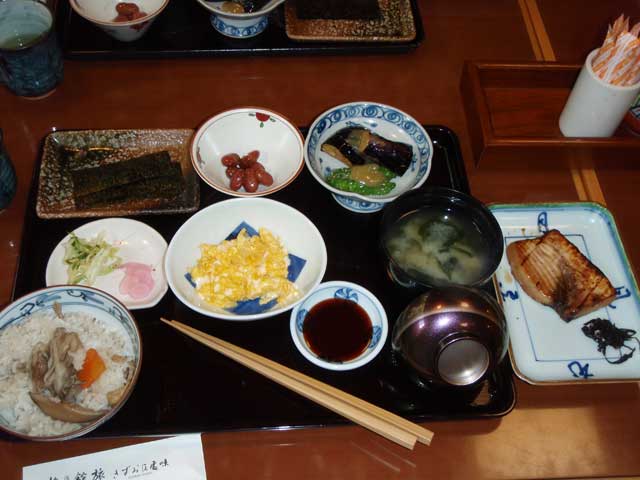
Another breakfast - Japanese style.

After breakfast (and before) we repacked our bags as we decamped on our way to Ōfuna station (in Kamakura). We waited until 0930 to let the rush dissipate from the Tōkyō Metro as we made our way to Shimbashi Station to catch the Japan Rail to our destination. The rail cars – except for the reserved “green card” seats – was configured as a subway car. We started the trip standing, but as folks got off and on we obtained seats. Once we arrived at ōfuna station, we dropped our bags at the hotel which was next door to the train station, and returned to the station to get on the Shonan Monorail. This monorail hangs below the rail as compared to the ones I had ridden in Seattle and Disneyland. It was not a novelty to the locals who use it as much as the train lines. The monorail took us toward the coast, terminating in Enoshima. Both Jonathan and I were impressed with the grades that the line took on its route. For the most part, there is a single track except at stations where they split so that they can run multiple “trains” on the line.
We then boarded the Enoshima Electric Railway, also on a single track, in Enoshima that threaded its way between buildings and occasionally down the middle of a street to Hase. For several miles, it runs along the coast for a very scenic ride.
We got off in Hase, a sea-side town that reminded both Cindy and me of Old Orchard Beach ME with the crowds and shops. There did not seem to be an equivalent to Palace Playland. We walked down to the beach where Mason wanted to wade in the shallows – claiming both sides of the Pacific.
We walked back and past the train station to the Hasedera Temple. We spent a goodly amount of time wandering the grounds while Mason explored the interior of the buildings in the complex.
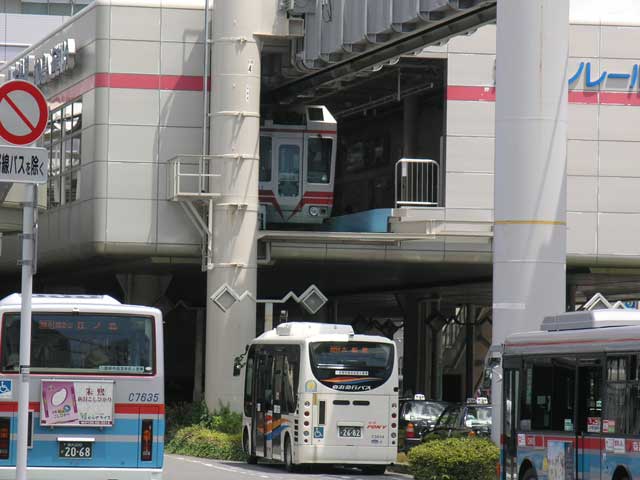
The monorail in the station - I didn't get the chance to record it in action (while standing on the ground).
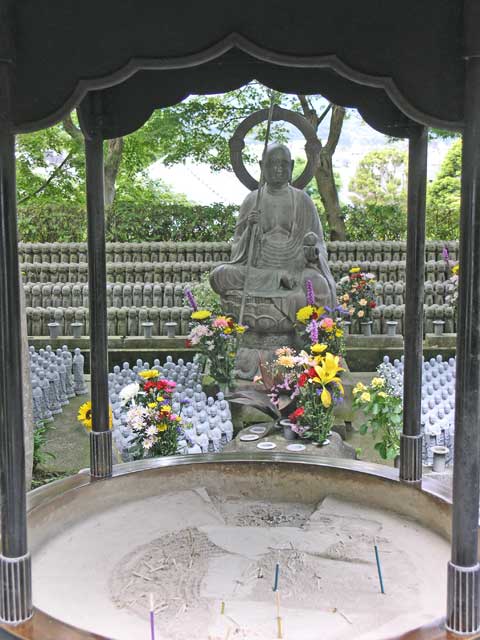
The sand-filled basin in the foreground is used for placing smoldering sticks of incense as offering.
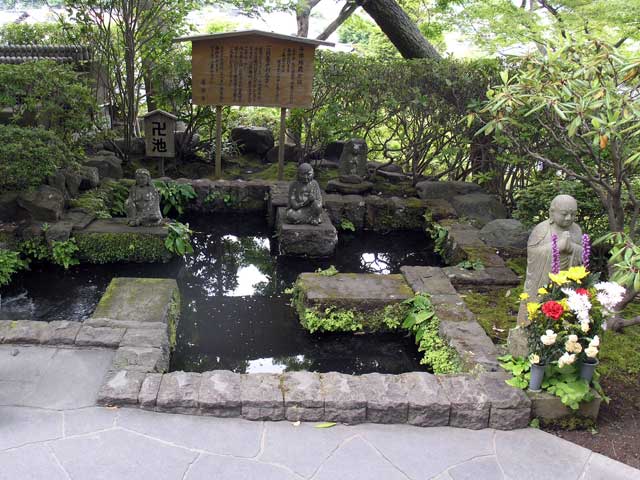
A pool in the shape of a swastika. In Eastern cultures it is a symbol of auspiciousness or well-being.
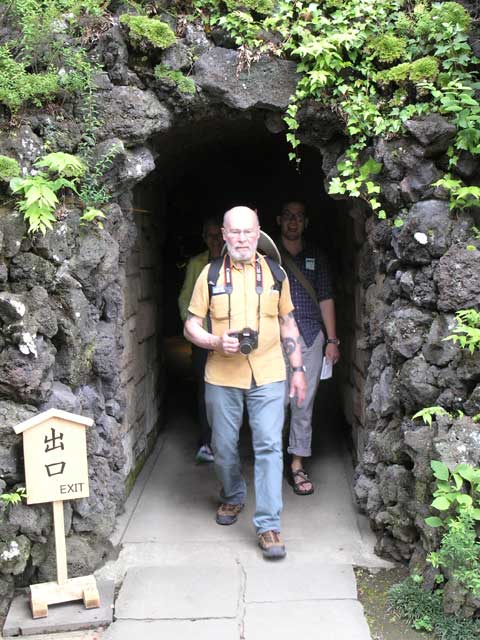
Jonathan, followed by Mason and Cindy, exit the grotto. It was setting off my clausterphobia - I exited quickly.
From there we walked further up the road to see the Great Kamakura Buddha. Before entering the temple grounds, we stopped for lunch at a restaurant across the street for what turned out to be a fine lunch. I had cold udon noodles with duck and onion while Jonathan had soba noodles in broth with tempura. Cindy, Mike, and Mason had an assortment of noodles and vegetable tempura. We all started with a beer. Afterwards, Mason got a Buddha cookie at the booth just outside the restaurant while I tried a skewer of rice(?) balls seasoned with sesame and soy. A few steps up the street there was a soft-serve ice cream stand that we all patronized with the Moorman-Kings sampling the green tea – chocolate combo, while I tried the mango – apple/banana combo. Mr. Lubin being the purist when it comes to ice cream had vanilla.
Through out our travels to date, the presence of uniformed school children has been ubiquitous, as if it is field trip season. While consuming our ice cream, a group of them asked us to sign their outing booklets that we did with a certain amount of amusement and delight. It didn’t let up after we walked across the street and entered the temple grounds as we signed a lot more booklets for the kids and Mason and Cindy posed for pictures with them.
After consulting all available maps, we sought out the hiking trail that would take us to Kamakura proper. The trailhead was further up the road, and up a long flight of steps and steep trail to the top of the ridge. From there the trail was less strenuous although there were some stretches of steps. The trail was packed earth and led through woodlands along the ridge top. We could hear a number of birds calling and more ominously thunder in the distance. There were only about a half-dozen other folks on the trail although we got passed by a couple of older gentlemen who were obviously in better shape than we.
Eventually the thunder became rain and then an downpour, as we pulled out our rain gear. We opted not to seek out the second leg of the trail, which was reportedly less well marked than the first, and followed the signs to the Kamakura train station down the hill from the ridge.
On the way down the narrow road, we spotted an arch that looked like it marked the spot of a shrine. The recess in the hill side turned out to be a pedestrian tunnel through the hill to a temple in the vale on the other side. This shrine (Zeniarai Benzaiten Ugafuku Shrine) was less elaborate than the previous ones, more elemental and primitive, and more powerful in my mind.

After a rest, we exited back through the tunnel to the road down into Kamakura. The rain had tapered off as we walked through town to the large shrine there. The grounds of the shrine (Tsurugaoka Hachiman-gū) were immense with the main building perched atop a stairway overlooking a green boulevard through Kamakura. Once we got to the top of the sixty-four steps (Mr. Lubin counted them), we looked around the shrine and were a little less impressed compared to the previous site despite its enormity.
Mike had identified a restaurant near a temple in the adjacent town over (Kita-Kamakura station). We found the temple (which was closed for the day) but no sign of the restaurant. So we continued our walk into town to the train station. We spotted an Italian-French restaurant that looked interesting, but without reservations, they would not seat us – despite only one table in the place being occupied.
With no other open restaurants in evidence, we took the train back to ōfuna where Mason picked a restaurant, Kafüne – there were sake bottles in the window, therefore it was good. And good it was. Cindy got a dish – essentially crudité – with a miso and red bean paste. I kept sampling the red bean paste the rest of the evening it was that tasty. I got sushi as did Jonathan, Mason got a pair of deep fried shrimp balls, I forgot what Mike had. But before it all, we had a round of Kirin beer that hit the spot. A second round was had later, although I demurred. We noted the irony of coming to a place for its sake display and having only beer. There were no English menus in the restaurant, so we ordered off the one with all the pictures. Afterwards we returned to the hotel, checked in and promptly retired.